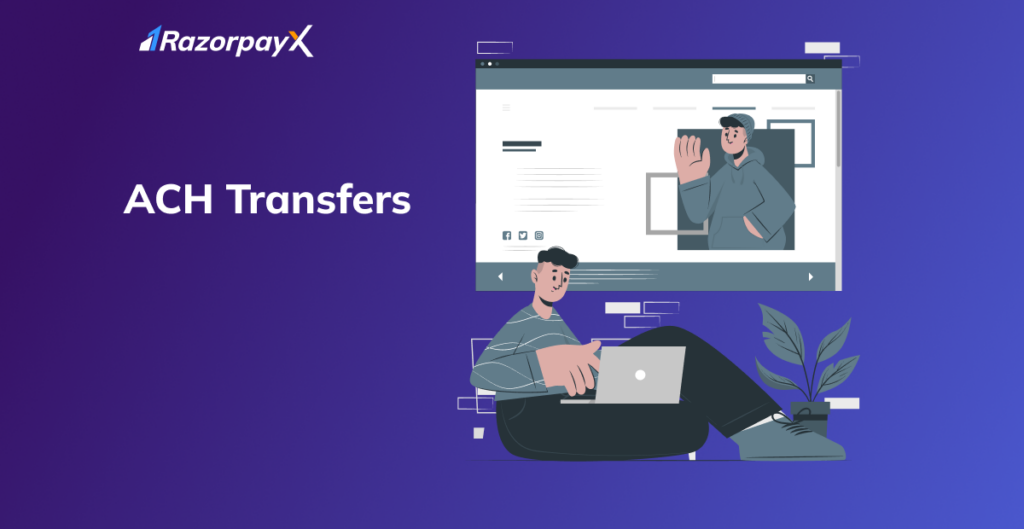The ACH network is a system that processes clear, and settles electronic payments between banks and financial institutions.
According to the 2013 Federal Reserve Payment Study, the number of transactions for debit cards and credit cards is 47bn and 23.8bn, respectively; both will continue to grow at a compounded annual growth rate (CAGR) of over 6.5 per cent.
Credit cards and Debit cards have gained popularity among businesses but even then businesses are exploring other modes of payment.
But why?
This is mainly because of the high processing cost pertaining to each transaction.
Enter ACH Transfer.
Table of Contents
What are ACH Transfers?
ACH transfers(Automated Clearing House) is an electronic funds transfer facility available to customers in the United States.
A consumer can use ACH transfers to transfer money online from one bank account to another.
So if you are in the United States and you want to send money to India, you can use the ACH transfer facility.
What is ACH used for?
ACH transfers can be used for paying bills or for sending funds as a direct deposit from one bank account to another.
Additionally, you can use ACH to transfer funds to pay for goods and services, or for peer-to-peer payments.
Today, the popularity of ACH transfer has seen a significant increase.
According to the National Automated Clearinghouse Association (Nacha), Q1 2019 ACH Network Volume grew 5.8% over Q1 2018. Of the 6% total volume in Q1 2019, 2.5B was credit, and 3.5B was debit.
Types of ACH Transfers:
ACH transfers make it easy to transfer money to family and friends, pay bills, and even buy items online. It is also a secure way to transfer money, as transfers are done through secure banking networks. With ACH transfers, money can be sent and received almost instantly.
The ACH Network processes two kinds of ACH transactions:
1. ACH Direct Deposit( ACH Credit)
This process involves the electronic transfer of funds from a business or government entity to a customer.
You can receive funds with the ACH Direct Deposit.
Examples of Direct Deposit include:
- Paychecks
- Employer-Reimbursed Expenses
- Government Benefits
- Tax Refunds
- Annuity Payments
- Interest Payments
2. ACH Direct Payments(ACH Debit)
This process involves the electronic fund transfer by an individual, businesses and other entities to send money. If you are paying a bill online we will call it an ACH Direct Payment.
The ACH direct-payment transaction is usually initiated by the sender providing the recipient with the necessary bank details. The sender then provides their bank with the details of the recipient and the payment amount. The bank then sends the information to the Automated Clearing House (ACH), which processes the payment.
Benefits of ACH Transfers
ACH transfers offer a number of advantages. Let’s have a look!
- Convenience: ACH payments can be set up to automatically debit a customer’s bank account on a specific date. This simplifies the payment process and allows businesses to receive payments quicker and more efficiently.
- Cost: ACH payments are typically cheaper than other payment methods, such as credit and debit cards. This makes them attractive to businesses that need to keep costs low.
- Security: ACH payments are secure because they are backed by the Federal Reserve, which means that the payments are protected from fraud and identity theft. Additionally, the ACH network is highly regulated, and only authorized parties can access the system. This makes it a safe and secure way to send and receive payments.
- Recurring Billing: ACH enables the facility of recurring billing. This makes it easier for businesses to manage their finances and for customers to keep track of their payments. With ACH, businesses can set up a recurring payment plan with customers, where payments are automatically deducted from the customer’s bank account. This eliminates the need for customers to write and mail checks each month, saving them time and effort. Additionally, it reduces the risk of late payments and the need for businesses to manually process payments
- Lower disputes: Credit cards and Debit cards have a higher rate of non-payment in comparison to ACH. This makes ACH transfers more efficient and allows you to send and receive payments with lower rates of non-payment.
- Environmental Friendly: ACH transfers saves companies time and money they would have spent processing paper checks. Electronic checks issued involve ink usage and fuel consumption while transporting checks. This will enable companies to reduce their environmental footprint.
What are the downsides to ACH Transfers?
ACH transfers enable convenience but come with a number of disadvantages as well:
ACH Transfer Limits
Banks might impose certain restrictions on the transaction limit- monthly/weekly/daily limits. And being completely aware of the transaction limits is crucial before going ahead with an ACH transfer.
Timezone Difference
Banks might be transferring funds across two time zones, so this means it’s important to get your transfer in within a cut-off time for the banks to have it processed for the next business day.
So if you are initiating an ACH transfer after the cut-off, it could result in a delay.
Penalty
Federal Reserve Regulation D governs the savings account and it may impose restrictions on withdrawals/transfer limits. If the limit is crossed with multiple ACH transfers from savings to another bank, an excess withdrawal penalty can be charged.
ACH Transfer vs Wire Transfer
Both ACH transfer and Wire transfer involve the movement of money from one bank to another. There are differences in how the exchange takes place, the cost, and security.
ACH transfers are processed by a central clearing house and are automated. Once initiated, it can take one to several business days to complete the transfer.
Whereas wire transfers involve the manual transfer of funds from one bank account to another. The transfers happen immediately and use the bank as the direct medium of transfer between two bank account holders.
Hence wire transfers are more expensive than ACH transfers. Wire transfers also cannot be reversed, hence ACH transfers are considered to be more secure.
ACH Transfer Cost
Businesses pay a flat fee per transaction which is again dependent on the payment provider. The cost of processing ACH transfers is very specific to the company’s payment provider. Generally, ACH transfers are less expensive in comparison to card transactions wherein the charges depend on the number of transactions and the average ticket size.
For example, Stripe charges a 2.9% + 30¢ fee for each ACH transfer, while Dwolla charges 25¢ per transfer. PayPal charges $0.25 per transaction, plus 1% of the amount, but the 1% fee is waived for account balances of $500 or more.
What’s needed to accept ACH payments?
ACH payments can be accepted by a business at the point of sale (POS), online, by phone, or by mail. If a business wants to receive ACH payments they need to make sure that its POS and accounting software is compatible with the transfer process.
➡️The customer’s bank may also require additional contact information such as an email address or mobile phone number to process the payment. This can be done at the POS with a check scanner to scan the customer’s check.
➡️Once you have enabled ACH payments in your current software, you’ll then need to set up a relationship with a payment processor and a bank to process the payments.
➡️Your payment processor will provide the necessary information to connect the bank account, and the bank will act as the intermediary between your payment processor and your customer’s bank.
➡️The bank will then take the information that your customer enters and verify the funds, and then process the payment to your account.
We can see how digital modes of payment have evolved.
This includes the development of best online payment gateway, mobile banking, and digital wallets. These platforms have enabled businesses to accept payments in a variety of formats, including credit and debit cards, electronic transfers, and digital currencies.
This has significantly reduced the amount of time and money spent processing payments, allowing businesses to focus more on their operations and customers. Additionally, these digital modes of payment have provided consumers with an easy and secure way to make payments, increasing customer satisfaction.
*Disclaimer: Please note that while we do not offer ACH transfers, our services are designed to simplify business banking operations and provide a seamless experience.
Similarly, banking has faced prominent evolution. The evolution of the fintech space has had a significant impact on businesses today.
Read more: What is Fintech? Meaning and Evolution
- RazorpayX allows business owners to open current accounts, pay taxes, schedule payments, pay vendors seamlessly and check invoices from a single dashboard. This saves valuable time and effort.
- It fills the gap between advanced banking solutions and finance professionals. It allows easy accounting software integration.
- With RazorpayX Payroll, businesses can automate salary payments and provide insurance policies to their employees.
Frequently Asked Questions
What is ACH transfer?
ACH transfers(Automated Clearing House) is an electronic funds transfer facility available to customers in United States.
What are the types of ACH Transfers?
There are two types of ACH transfers and they are as follows:
ACH Direct Deposit( ACH Credit)
ACH Direct payments( ACH Debit)
Can ACH be used to accept checks by phone?
Yes. Customers appreciate the convenience and ease of paying with an echeck by phone.
What types of transactions can be processed through the ACH network?
ACH gives you the ability to accept payments online, take checks by phone, or to directly debit or credit bank accounts on a one-time or recurring basis.



